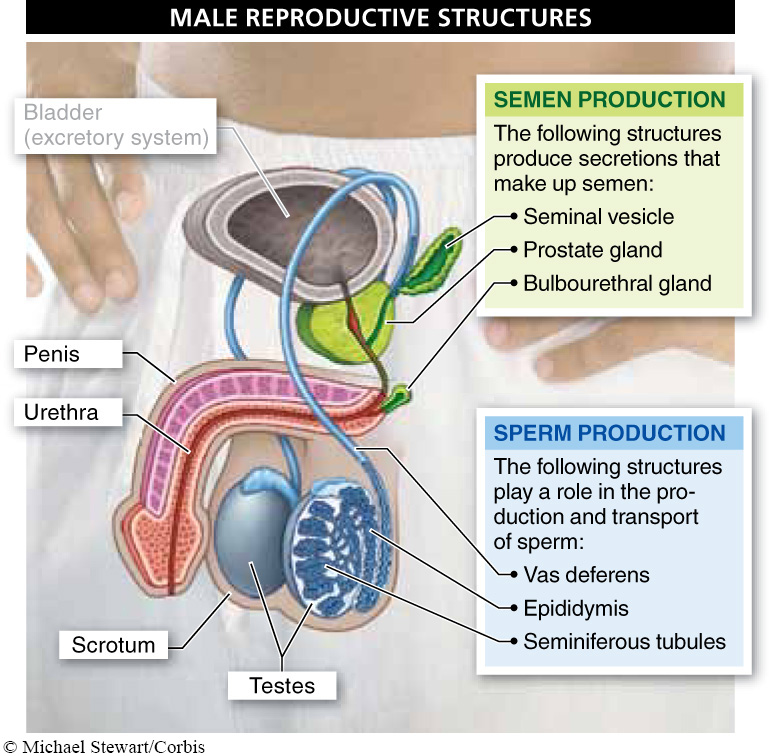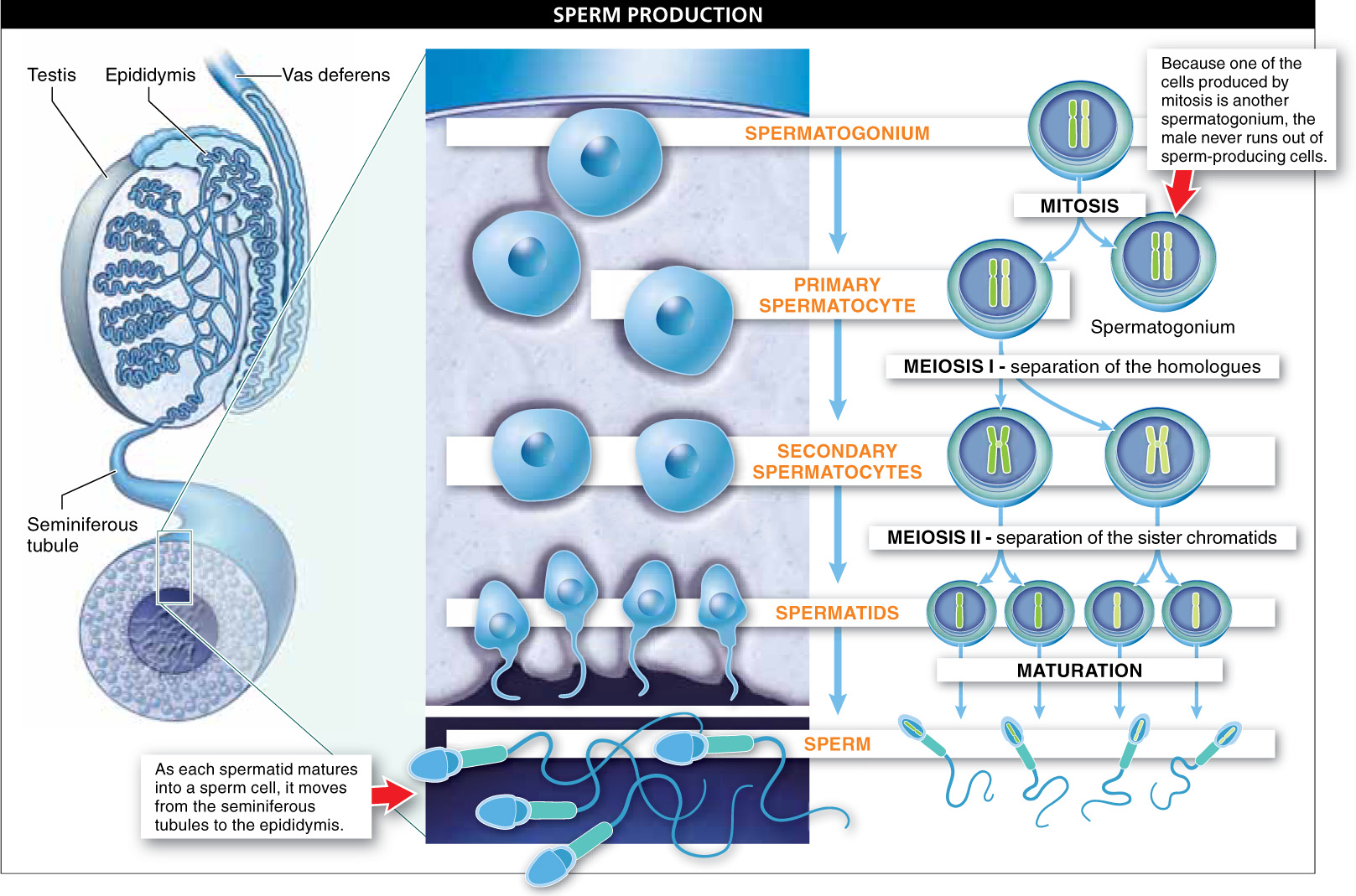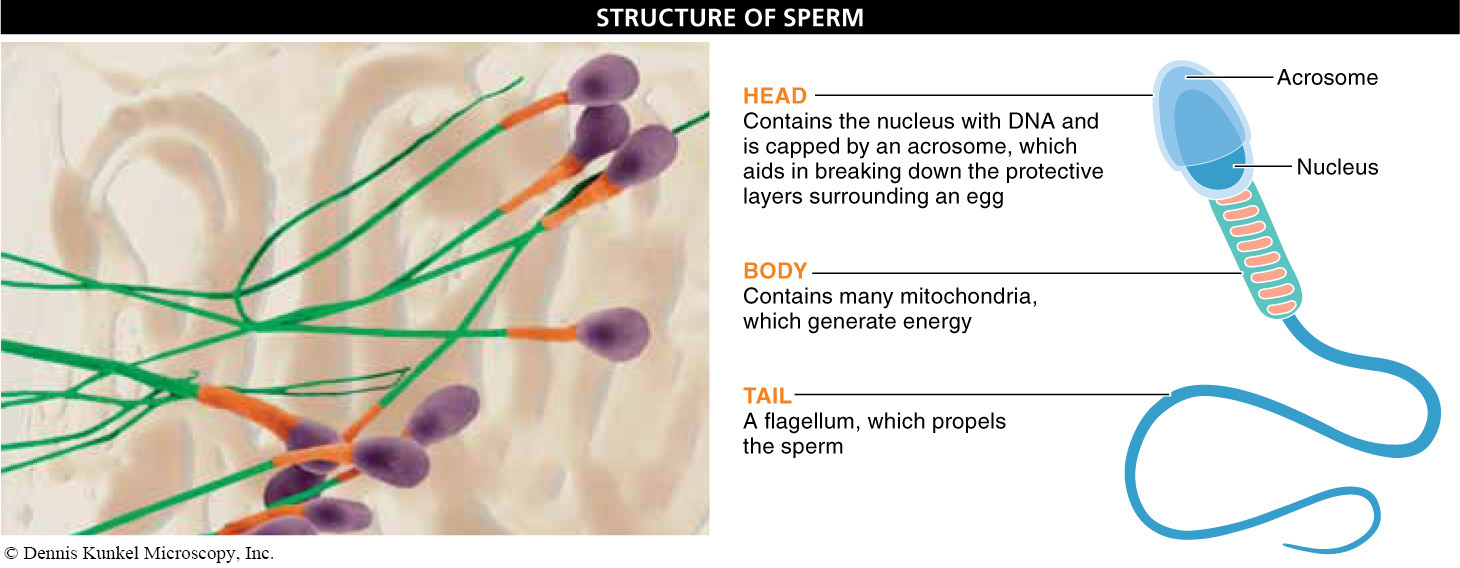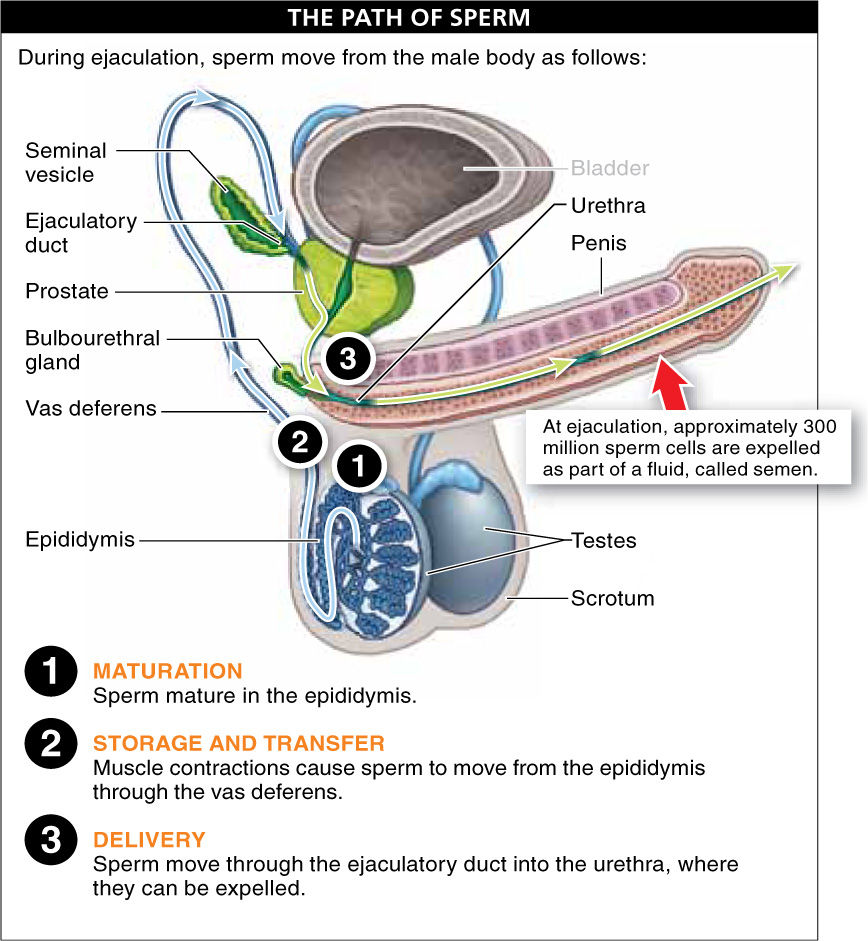25.4–25.8: Male and female reproductive systems have important similarities and differences.

From Here to Eternity, 1953.
25.4: Sperm are made in the testes.

Figure 25.8: The structures of the male reproductive system.
Beginning at puberty and continuing for their entire lives, men produce sperm, often more than 100 million per day. The process of sperm production, called spermatogenesis, is similar among most mammals and requires 9–10 weeks in humans. In this section, we examine the male reproductive system and the production of sperm and semen, a fluid expelled at ejaculation that usually contains sperm. We begin with the male reproductive structures and the role that each plays in the process of sperm formation and fertilization (FIGURE 25-8).
Male Reproductive Structures Externally, a male has just two reproductive structures, the penis and the scrotum. The penis has three columns of tissue—one along each side and a third underneath—that can become engorged with blood, causing erection and making copulation possible. In most animal species, including dogs, walruses, and most primates other than humans, a bone (known as a baculum) is present in the penis and contributes to its stiffness. The scrotum, generally on the outside of the body, is a sac containing the two testes (sing. testis; also called testicles), the site of sperm production. Each testis is made up of highly coiled seminiferous tubules, lined with cells, called spermatogonia, that are the site of sperm production. It is in cells between the seminiferous tubules that testosterone, the principal male sex hormone, and other androgens are produced. Testosterone stimulates sperm production.
Connected to the seminiferous tubules is the epididymis, a 15- to 20-foot-long coiled tube, in each testis, where sperm mature. The epididymis in each testis is linked to a vas deferens, a tube of smooth muscle tissue that passes from the testis into the body. The vas deferens from each testis connects to a single ejaculatory duct, which continues into the urethra, a duct passing through the penis and through which semen and urine are expelled. Sperm make up 1% to 5% of the semen volume in an ejaculate.

Figure 25.9: Gametogenesis in males. Sperm are continuously produced in the testis by meiosis.
Three other important male reproductive structures produce secretions that make up semen. These include the prostate gland, located just below the urinary bladder, which secretes into the urethra a milky, basic (as opposed to acidic) fluid containing enzymes and sperm nutrients that makes up just under one-third of the volume of the ejaculate. A pair of seminal vesicles secrete into the semen nutrients for the sperm, as well as substances that increase sperm motility and make the female reproductive tract more hospitable to the sperm. These secretions make up about 65% of the volume of the ejaculate. And finally, a pair of bulbourethral glands, located just below the urethra near the base of the penis, contribute the remaining 1% or so of the ejaculate, as well as a mixture of mucus and sugar that lubricates the tip of the penis prior to copulation.
Gametogenesis in Males Recall from Sections 6-9 through 6-13 that gametes are produced by cells that undergo meiosis. Diploid cells, the spermatogonia, are present in the highly coiled seminiferous tubules of the testes (FIGURE 25-9). Each spermatogonium divides by mitosis to produce two cells. One of these cells is another spermatogonium, so the male never runs out of a store of sperm-producing cells; the other is a primary spermatocyte, which undergoes meiosis, in the first step of sperm production. Each primary spermatocyte produces two cells in the first meiotic division. These two cells are called secondary spermatocytes, and they then complete the second meiotic division, each producing two spermatids. The four spermatids produced by each spermatogonium, as products of meiosis, are haploid. As each spermatid matures into a sperm cell, it moves from the seminiferous tubules to the epididymis, where, over the course of approximately 18 hours, the sperm become motile.

Figure 25.10: Sperm structure reflects its function.
Each sperm cell consists of three primary parts: (1) the head region, containing the nucleus with its DNA, plus a cap-like acrosome containing enzymes that can break down the protective layers surrounding an egg; (2) the body region, which contains many energy-generating mitochondria; and (3) the tail, a flagellum that propels the sperm through the fluid in the female reproductive tract (FIGURE 25-10).
Sperm production is tremendously sensitive to numerous factors. Two of the most important are hormones and temperature. The optimum temperature for sperm production is approximately two degrees lower than body temperature. This is why, in most mammals, the testes hang outside the body, where their temperature can be controlled by moving them closer to or farther from the heat of the body. It’s also why men exposed to hot tubs or hot baths for 30 minutes or more each week generally show signs of infertility, with lower sperm count and motility. Fortunately, the condition can almost always be reversed by reducing exposure to the hot tubs or baths.
Q
Question
25.4
Do hot tubs reduce a man’s fertility?

Figure 25.11: The pathway taken by sperm during ejaculation.
The path taken by sperm, from the male to the female, is as follows (FIGURE 25-11):
- 1. Maturation: sperm mature in the epididymis, within each testis.
- 2. Storage and transfer: during ejaculation, sperm move from the epididymis (in each testis) through the vas deferens as a result of contractions of the muscular tissue of the vas deferens.
- 3. Delivery: sperm moving from each vas deferens pass through the ejaculatory duct and into the urethra. During copulation, sperm are ejected from the urethra into the female reproductive tract.
At ejaculation, approximately 300 million sperm cells are expelled as part of the semen. In the next section, we explore why so many sperm are present in an ejaculation.
TAKE-HOME MESSAGE 25.4
In adult men, sperm are continuously produced in the testes by meiosis. Semen—consisting of sperm cells and fluids that nurture and aid the sperm in fertilization—is ejaculated during copulation.
How do the seminal vesicles contribute to the production of semen?




